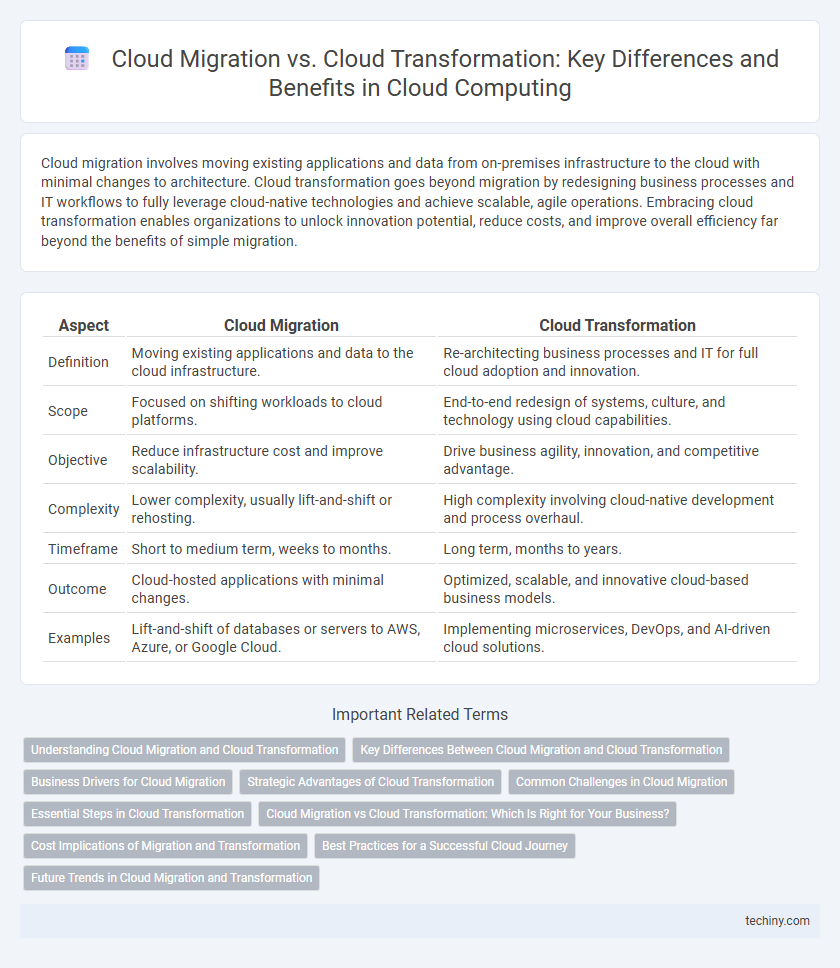Cloud migration involves moving existing applications and data from on-premises infrastructure to the cloud with minimal changes to architecture. Cloud transformation goes beyond migration by redesigning business processes and IT workflows to fully leverage cloud-native technologies and achieve scalable, agile operations. Embracing cloud transformation enables organizations to unlock innovation potential, reduce costs, and improve overall efficiency far beyond the benefits of simple migration.
Table of Comparison
| Aspect | Cloud Migration | Cloud Transformation |
|---|---|---|
| Definition | Moving existing applications and data to the cloud infrastructure. | Re-architecting business processes and IT for full cloud adoption and innovation. |
| Scope | Focused on shifting workloads to cloud platforms. | End-to-end redesign of systems, culture, and technology using cloud capabilities. |
| Objective | Reduce infrastructure cost and improve scalability. | Drive business agility, innovation, and competitive advantage. |
| Complexity | Lower complexity, usually lift-and-shift or rehosting. | High complexity involving cloud-native development and process overhaul. |
| Timeframe | Short to medium term, weeks to months. | Long term, months to years. |
| Outcome | Cloud-hosted applications with minimal changes. | Optimized, scalable, and innovative cloud-based business models. |
| Examples | Lift-and-shift of databases or servers to AWS, Azure, or Google Cloud. | Implementing microservices, DevOps, and AI-driven cloud solutions. |
Understanding Cloud Migration and Cloud Transformation
Cloud migration involves relocating digital assets, applications, and data from on-premises infrastructure to cloud environments, primarily aiming to improve scalability and reduce costs. Cloud transformation encompasses a comprehensive redesign of business processes, applications, and IT infrastructure to fully leverage cloud-native technologies and agile methodologies, enhancing innovation and operational efficiency. Understanding the distinctions highlights that migration is a tactical move to the cloud, while transformation drives strategic business change through cloud capabilities.
Key Differences Between Cloud Migration and Cloud Transformation
Cloud migration involves relocating applications, data, and workloads from on-premises servers to cloud infrastructure, primarily aiming for improved accessibility and cost efficiency. Cloud transformation encompasses a broader scope, integrating cloud-native technologies, redesigning business processes, and leveraging automation to drive innovation and agility. The key difference lies in migration's focus on shifting existing systems versus transformation's focus on re-architecting and optimizing for full cloud capabilities.
Business Drivers for Cloud Migration
Business drivers for cloud migration primarily include cost reduction, scalability, and enhanced operational efficiency by moving existing applications and data to cloud infrastructure. Companies seek to improve agility, enable remote access, and leverage cloud-native services without overhauling legacy systems. Cloud migration aims to optimize current workloads, whereas cloud transformation involves reimagining business processes to fully exploit cloud capabilities.
Strategic Advantages of Cloud Transformation
Cloud transformation offers strategic advantages by enabling organizations to redesign business processes, innovate with advanced cloud-native technologies, and achieve scalability beyond simple infrastructure migration. It supports comprehensive modernization, including cultural shifts and agility improvements, driving long-term competitive differentiation. Cloud transformation maximizes cloud investment returns through enhanced flexibility, faster time-to-market, and improved operational efficiency.
Common Challenges in Cloud Migration
Cloud migration often encounters challenges such as data security risks, compatibility issues with legacy systems, and downtime during the transfer process. Organizations must address insufficient cloud expertise and cost overruns caused by unplanned resource consumption. Effective planning and selecting the right migration tools are critical to overcoming these common obstacles in cloud migration projects.
Essential Steps in Cloud Transformation
Cloud transformation involves a strategic overhaul of an organization's IT infrastructure, applications, and processes to fully leverage cloud capabilities, unlike cloud migration which primarily focuses on moving existing workloads to the cloud. Essential steps in cloud transformation include assessing current IT landscapes, redesigning applications for cloud-native environments, implementing automation and DevOps practices, and ensuring robust security frameworks. Continuous monitoring, optimization, and alignment with business goals drive successful cloud transformation, enhancing scalability, agility, and innovation.
Cloud Migration vs Cloud Transformation: Which Is Right for Your Business?
Cloud migration involves transferring existing applications and data to the cloud, focusing on lifting and shifting workloads to improve scalability and reduce infrastructure costs. Cloud transformation goes beyond migration by redesigning business processes and IT architecture to fully leverage cloud-native capabilities, driving innovation and agility. Choosing between cloud migration and cloud transformation depends on your business goals, resource availability, and the desired pace of digital evolution.
Cost Implications of Migration and Transformation
Cloud migration primarily involves moving existing applications and data to the cloud, often resulting in upfront costs associated with rehosting and data transfer but offering predictable expenses post-migration. Cloud transformation entails rearchitecting systems to leverage cloud-native features, which incurs higher initial investment due to development and integration efforts but drives long-term cost savings through improved scalability and operational efficiency. Organizations must evaluate these cost implications carefully to balance immediate expenditures against future financial benefits and innovation potential.
Best Practices for a Successful Cloud Journey
Effective cloud migration requires thorough assessment of existing IT assets, careful selection of the right migration strategy, and robust data security measures to minimize downtime and ensure business continuity. Cloud transformation involves re-architecting applications, adopting cloud-native services, and integrating automation to fully leverage scalability, agility, and cost-efficiency intrinsic to cloud platforms. Best practices include continuous monitoring, employee training, and collaboration between cross-functional teams to drive innovation and maximize return on investment during the cloud journey.
Future Trends in Cloud Migration and Transformation
Future trends in cloud migration emphasize automated, AI-driven processes that reduce complexity and downtime while optimizing resource allocation and cost-efficiency. Cloud transformation increasingly leverages hybrid multi-cloud strategies, edge computing, and serverless architectures to enhance scalability, performance, and business agility. Advanced security frameworks and continuous compliance monitoring are becoming integral to cloud adoption, ensuring robust protection against evolving cyber threats.
Cloud Migration vs Cloud Transformation Infographic

 techiny.com
techiny.com